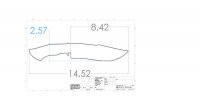- Joined
- Aug 11, 2011
- Messages
- 828
how do i put these drawings onto paper with exact dimensions?
i would like the hunter to have a 4.5" blade and the Bowie to have a 8.5" blade
what is the proper way to put these drawings on paper with exact dimensions, so that when i give them to a maker he could trace them directly onto his template?
as they were drawn, the dimensions are just eyeballed, in other words, the blade/grip as drawn might not be to scale(definitely not) or proportioned evenly

i would like the hunter to have a 4.5" blade and the Bowie to have a 8.5" blade
what is the proper way to put these drawings on paper with exact dimensions, so that when i give them to a maker he could trace them directly onto his template?
as they were drawn, the dimensions are just eyeballed, in other words, the blade/grip as drawn might not be to scale(definitely not) or proportioned evenly





